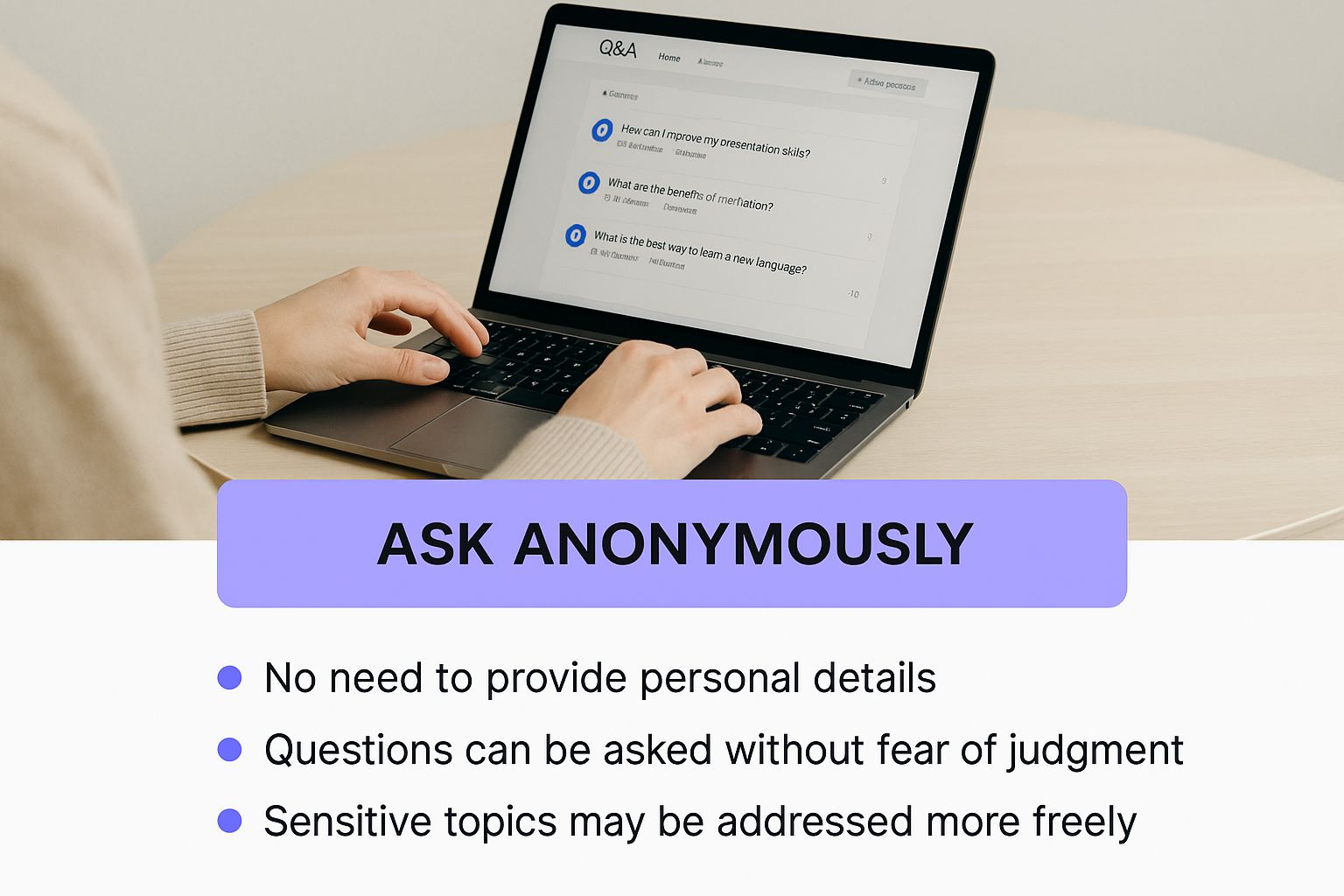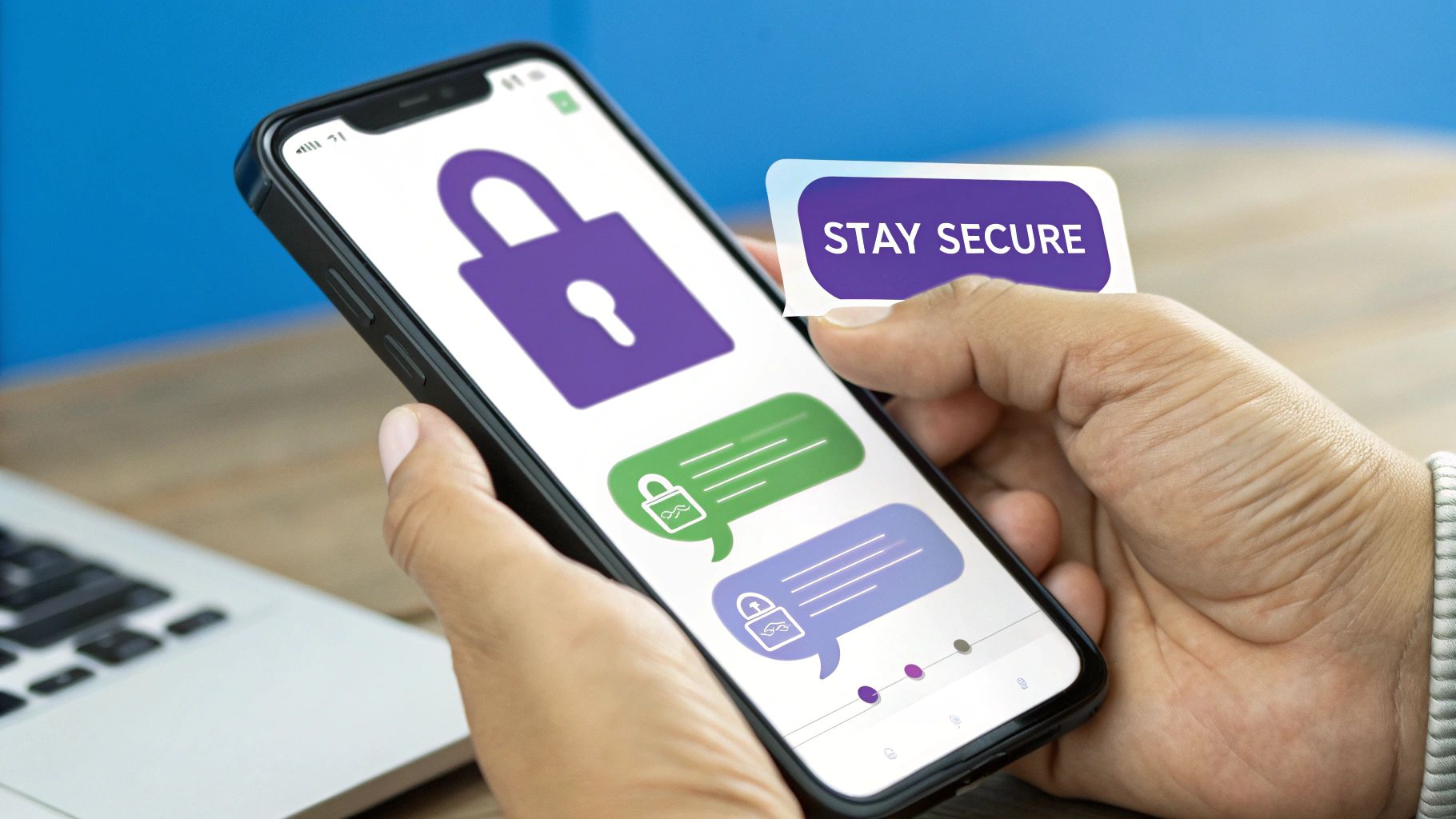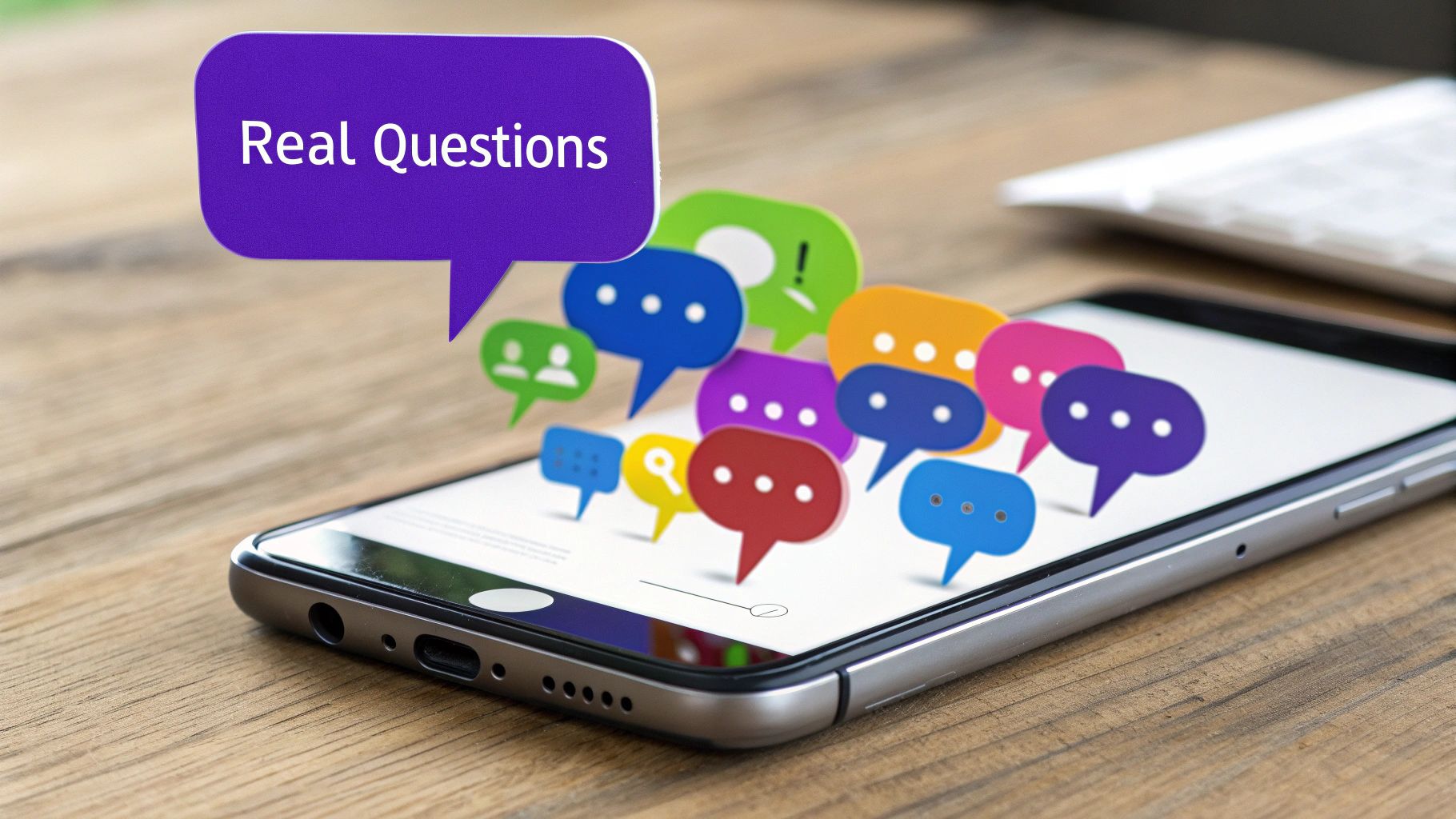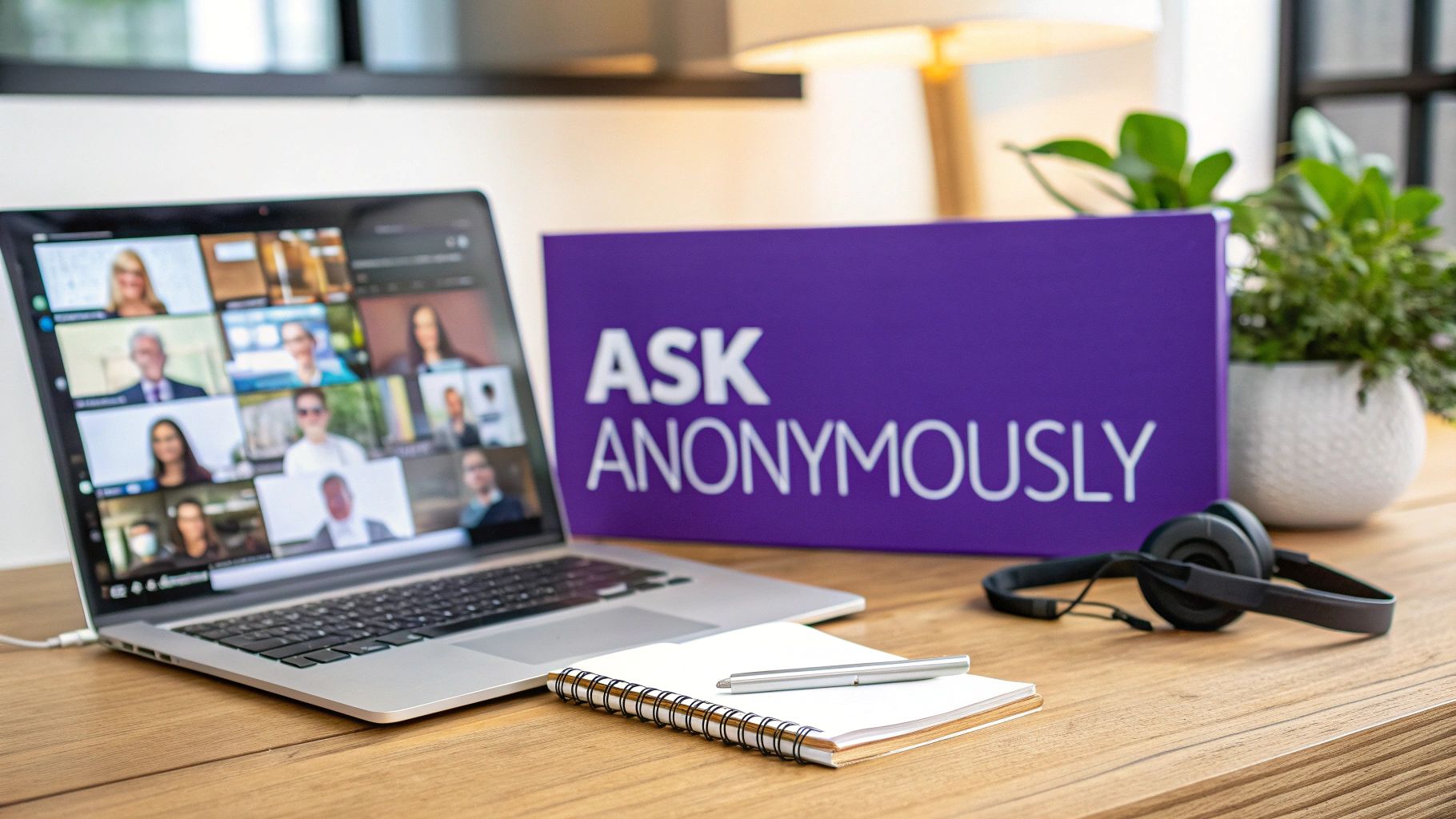When you give your team a safe place to ask questions anonymously, you’re doing more than just collecting feedback. You’re fundamentally changing the dynamic of your team for the better, especially when everyone’s remote. It’s a game-changer for building real trust and open communication.
This approach works because it removes the fear of judgment. Suddenly, people feel comfortable voicing the concerns they’d normally keep to themselves, asking for clarity on sensitive topics, or even sharing bold ideas they were too hesitant to attach their name to.
Why Anonymous Questions Build Stronger Teams
Let’s be honest: in almost every company, there’s a gap between what people are really thinking and what they’re willing to say in a meeting. No one wants to look silly, challenge their manager, or come off as negative. This can create a culture of silence where important issues fester just below the surface.
Allowing people to ask questions anonymously completely shifts this dynamic.
By creating a channel for truly unfiltered feedback, you’re building genuine psychological safety. The team member who would never risk asking a “dumb question” or raising a sensitive concern with their name on it now has a voice. This isn’t about creating a space for people to vent; it’s about getting to the truth.
Uncovering Hidden Problems
I’ve found that some of the most crucial insights come from the quietest people on the team. Anonymity gives a voice to your introverts or those who are less confident, making sure their valuable perspectives don’t get lost in the noise.
You might be surprised by what you uncover:
- Confusion over big-picture strategy: A question like, “I’m still a bit unclear on why we shifted focus from Project X to Project Y,” is a clear signal that leadership needs to communicate more effectively.
- Pain points in daily workflows: Someone might ask, “The new reporting tool is adding an extra hour of work to my week. Is there a simpler way to do this?”
- Friction between team members: A general question about collaboration styles can often hint at underlying tensions that need a manager’s attention.
Getting this level of raw honesty is nearly impossible in a typical team meeting or a public Slack channel. There’s plenty of research to back this up, too. A 2020 study confirmed that people are far more willing to share truthful information on sensitive topics when they can do so anonymously. When you remove the social pressure, you get honesty.
“The magic of an anonymous Q&A is that it surfaces the real questions—the ones people are thinking but not saying. It’s a direct line to your team’s collective consciousness.”
Fostering a Culture of Trust
At the end of the day, simply inviting and thoughtfully answering anonymous questions is a powerful way to build trust. It sends a clear message to your team: your voice matters, even when it’s hard to hear. This is just one of many fantastic virtual team engagement ideas that can seriously strengthen your remote culture.
When leaders tackle tough questions with transparency and respect, they show they’re humble and committed to getting better. It closes the feedback loop and proves that speaking up actually leads to change, which only encourages more great feedback down the line.
Choosing the Right Platform for Anonymous Q&A
Picking the right tool is the first, and arguably most important, step when you decide to ask anonymous questions. This isn’t just a logistical choice; it’s a decision that directly impacts your team’s psychological safety and their willingness to actually speak up. A clunky, confusing, or untrustworthy platform can kill the whole initiative before you even get started.
You’ll find a whole spectrum of options out there, from slick, dedicated apps to simple features already baked into the software your team uses every day. The best one for you really boils down to your team’s specific needs, what your budget looks like, and how much security everyone expects.
Think about it from the employee’s perspective. The moment they go to ask a question, the interface should feel clean, simple, and secure.

If the user experience doesn’t scream “this is safe and anonymous,” you’ve already lost.
Evaluating Your Platform Options
When you start looking, you’ll see that most tools fall into one of three buckets. Each has its own pros and cons, and understanding them will help you make a smart decision.
- Dedicated Q&A Apps: I’m talking about tools like Bulby, Slido or Polly. These are purpose-built for engagement. They plug right into Slack or Microsoft Teams and come loaded with powerful features like question upvoting, moderation dashboards, and detailed analytics. Since their entire business model is built on facilitating these conversations, they usually have rock-solid privacy policies, which is a huge plus for building team confidence. The trade-off? They typically come with a subscription fee.
- Features Within Collaboration Hubs: Many of the big platforms, like Microsoft Teams with its native Q&A, are adding these features. The biggest win here is convenience. It’s already part of your team’s daily life, so there are no new apps to install or logins to remember. But be careful—sometimes the anonymity features aren’t as robust or as clearly explained, which can make some people nervous about participating.
- Simple, Free Tools: For teams on a shoestring budget, you can’t go wrong with something like Google Forms or SurveyMonkey. You can quickly spin up a form that doesn’t require a login, making it a decent way to collect questions. While it’s free and easy, this approach is pretty static. You lose all the dynamic, real-time magic of dedicated apps, like live upvoting during a town hall. It feels more like a digital suggestion box than an interactive dialogue.
Making the Right Choice for Your Team
So, how do you pick? It really depends on your company’s context.
For a small, high-trust startup, a simple Google Form might be perfectly fine for gathering questions ahead of a meeting. But for a large enterprise navigating a sensitive topic like a major reorganization, investing in a dedicated tool like Slido is a much smarter move. The perceived legitimacy and security of a professional platform can be the difference between a handful of questions and a flood of valuable, honest feedback.
The best tool is the one your team actually trusts. It doesn’t matter how convenient a built-in feature is if your employees are skeptical about its anonymity. Their perception is your reality.
To help you visualize the trade-offs, here’s a quick breakdown of the most common options.
Comparing Anonymous Q&A Tools for Modern Teams
Choosing a platform can feel overwhelming, but this table cuts through the noise. It compares some of the most popular options, focusing on what really matters: how anonymous they are, what they can do, and where they shine.
| Tool/Platform | Anonymity Level | Key Features | Best For |
|---|---|---|---|
| Dedicated Apps (Bulby, Slido) | High | Question upvoting, live polls, moderation, analytics, app integrations. | All-hands meetings, town halls, and teams handling sensitive change management. |
| Integrated Features (Teams Q&A) | Moderate | Basic Q&A, built into existing workflow, controlled by meeting settings. | Regular team meetings, project updates, and organizations deeply embedded in one ecosystem. |
| Free Form Builders (Google Forms) | Moderate to High | Simple question submission, easy setup, results in a spreadsheet. | Small teams, pre-meeting question collection, and organizations with zero budget for new tools. |
Ultimately, your goal is to choose a platform that just works, fading into the background so the focus can stay where it belongs: on open, candid communication. The right tool will feel like a natural extension of your company culture and help you achieve the goals you set for your Q&A session.
Laying the Groundwork for a Great Q&A Session

A productive session where people feel genuinely safe to ask anonymous questions doesn’t just happen. It’s something you build intentionally, laying a foundation of clear communication and thoughtful prep work long before the first question is ever submitted.
Think about it. If you just drop a Q&A link into a channel without any context, it can feel a bit strange, maybe even a little suspicious. People will naturally wonder, “Why now? What’s the real reason for this?” Your first job is to get ahead of that and frame the conversation yourself.
Start by being upfront about the “why.” Send out an announcement explaining what you hope to achieve. Are you looking for honest feedback on a new company-wide initiative? Trying to smooth out some clunky team processes? Or just making sure everyone has a voice during a big transition? When you’re transparent about your motives, you build trust right from the get-go.
Set Some Clear Ground Rules
Anonymity is a fantastic tool, but it needs a few guardrails to keep the discussion helpful and respectful. Without any rules of engagement, you run the risk of the session turning into a free-for-all of venting or, worse, personal attacks.
Before you open the floor to questions, share a few simple guidelines. Here’s what I recommend:
- Focus on ideas, not individuals. It’s about challenging a process or a strategy, not criticizing a person.
- Aim for constructive feedback. Frame questions to find solutions or gain clarity, not just to complain.
- Keep it professional. All comments and questions should fall within your company’s code of conduct.
These rules aren’t there to shut down difficult conversations. Quite the opposite. They channel that honest energy in a productive direction, ensuring that even the tough questions lead to positive change instead of creating resentment. Plus, when you establish these boundaries early, you give your moderator the authority they need to steer the conversation effectively.
A study on training effectiveness found that defining clear objectives is a critical factor for success. The same logic applies here. When people know the goal and the rules, they’re far more likely to contribute in a meaningful way.
Handle the Logistics and Set Expectations
The how and when of your Q&A can make or break its success. If you just throw a last-minute meeting on everyone’s calendar, you can expect low engagement and half-baked questions.
You need to give people time to think. One of the best things you can do is open the anonymous question channel 24 to 48 hours before the live discussion. This is a game-changer. It gives introverts, people in different time zones, and just plain busy folks a chance to gather their thoughts without feeling put on the spot.
It’s also crucial to set expectations for how you’ll handle the questions. Be transparent. Let everyone know that you might group similar questions into themes to tackle the root issues more efficiently. Reassure them that every topic will be acknowledged, even if a more detailed answer has to come later. This simple act of communication shows you respect everyone’s input and prepares them for a focused, high-impact session.
How to Moderate Your Q&A Like a Pro

Running a Q&A session can feel a bit like walking a tightrope. On one side, you have chaos; on the other, a conversation that builds real trust. The secret to staying balanced? Solid moderation.
As a facilitator, you’re more than just a question-reader. You’re the conductor of the conversation, setting the tone and making sure everyone, even the quietest person, feels safe enough to contribute.
A good moderator sees the forest for the trees. When questions start rolling in, you’ll naturally spot recurring themes. Instead of asking five slightly different questions about the new vacation policy, you can group them. It’s a simple move, but it shows your team you’re not just listening to the words—you’re hearing the underlying concern.
Rephrasing for Productive Conversations
Let’s be honest, not every question submitted is going to be a home run. Some will be vague, others emotionally charged, and some just… awkward. That’s where you come in. Your job is to find the constructive nugget inside and polish it up.
Think of rephrasing as your superpower.
Imagine you get a question like this: “Why is the marketing team getting all the budget while we have to make do with nothing?”
Reading that out loud is a recipe for instant tension and finger-pointing. It puts everyone on the defensive. Instead, try filtering it through a more productive lens:
“We have a question here about how we allocate budgets across different departments. It sounds like someone wants to better understand the decision-making process and how we can make sure all teams feel they have the resources they need to succeed. That’s a great topic, let’s dig into that.”
See the difference? You’ve validated the employee’s concern without pouring fuel on the fire. You’ve turned a complaint into a conversation about fairness and process, which is something everyone can benefit from. This is a crucial skill for any leader, and we cover more techniques in our guide to remote facilitation best practices.
Handling Tricky Questions with Grace
Sooner or later, you’re going to get a tough one. It might be a question that calls out a specific person, or it might be something you genuinely don’t have an answer for. How you handle these moments is what truly builds—or breaks—trust.
When a question targets an individual:
- Don’t read it. Ever. Your first duty is to psychological safety. Personal attacks have no place here.
- Find the theme. If the question hints at a missed deadline, reframe it. “We’ve got a question about project timelines and workload. It’s a good time to check in on how we can better support each other to hit our goals.”
- Follow up in private. If there’s a legitimate issue buried in the poorly worded question, address it offline with the right people.
When you just don’t know the answer:
- Own it. Don’t dodge the question. Simply say, “That’s a really important question, and I want to give you a complete answer. I don’t have all the info I need right now.”
- Promise a follow-up. Give a specific timeline. “Let me look into this, and I’ll post an update in the team channel by EOD tomorrow.” Following through on this is non-negotiable.
It’s also helpful to remember why people ask certain things anonymously in the first place. Research shows the decision is highly dependent on the topic. By understanding the context behind a sensitive question, you can moderate with more empathy and skill, reinforcing that this is a safe and valuable way for your team to communicate.
Turning Anonymous Feedback into Actionable Change
The Q&A session might be over, but the real work is just getting started. The true measure of success isn’t just getting your team to ask anonymous questions—it’s what you do with that information. If you don’t follow up in a meaningful way, the whole thing can feel like a waste of time, chipping away at the trust you’re trying to build.
First things first: you need to make sense of all the feedback. Instead of tackling each question one by one, step back and look for the bigger picture. Start grouping the submissions by topic. You’ll probably notice that what looks like five separate questions are actually all circling the same core issue, whether that’s confusion about a new workflow or a lack of clarity on project goals.
This is how you move from just reacting to addressing what’s really going on. Pinpointing these recurring themes is the most important part of turning a pile of raw feedback into a focused plan.
Creating a Transparent Action Plan
Once you have your themes sorted out, it’s time to share what you’ve learned with the team. You absolutely have to be transparent here. Put together a simple document or a quick presentation that outlines the main takeaways from the Q&A.
For each major theme you identified, your plan needs to be crystal clear.
- The Core Issue: Briefly summarize the feedback in neutral terms. For example, “Several questions pointed to confusion around our Q3 product roadmap.”
- Committed Actions: What specific steps will you take? Maybe it’s scheduling a dedicated roadmap deep-dive or revising a process document.
- Clear Ownership: Who’s on point for this? Putting a name next to an action item creates real accountability.
- A Realistic Timeline: When can the team expect an update or see a change? Give them a concrete timeframe.
Closing the loop like this shows everyone that leadership is actually listening and that the process has a purpose. It turns a one-off event into an ongoing cycle of improvement. If you’re stuck on how to solve some of the issues raised, our guide on creative thinking exercises for teams can offer some fresh ideas.
The Importance of Follow-Through
Acting on feedback is critical. In a world where online privacy is a massive concern for everyone, especially for people aged 15-36, proving you respect anonymity is key. A global survey showed a widespread desire for platforms that allow for private expression. You can meet this need by demonstrating that the anonymous feedback your team provides leads to tangible change.
By consistently reporting back on progress, you prove that your commitment to listening is genuine. This encourages even more honest participation in the future and solidifies a culture where every voice truly matters.
After collecting the anonymous questions, analyzing the responses to drive these improvements is the essential next step. For a more structured approach, checking out a comprehensive guide to analyzing customer feedback effectively can give you some valuable frameworks to work with.
Common Questions About Anonymous Q&A
Even with the best of intentions, opening the floor to anonymous feedback can feel like you’re walking into the unknown. I’ve seen leaders hesitate, and it’s usually the same worries that pop up. Let’s tackle those common concerns head-on, so you can run a session that genuinely strengthens your team, not just adds stress.
One of the biggest fears? That anonymity will just become a shield for negativity and complaints. It’s a fair concern, and frankly, it’s why setting clear ground rules and having solid moderation isn’t just a nice-to-have—it’s essential.
What If Someone Is Unprofessional?
This is precisely where your moderator proves their worth. Before you even start, you need to clearly state the house rules: every question, even a critical one, must be constructive and respectful.
If an unprofessional question does come through, the moderator’s job isn’t to put it on blast. It’s to find the constructive root of the issue.
For example, a question that personally attacks a team member should never be read aloud. A good moderator can reframe it: “We have a question here raising concerns about project leadership. Let’s talk about how we can improve our project management process for everyone.” See how that shifts the focus? It steers the conversation toward a productive outcome without rewarding a toxic tone. When you consistently model this approach, you’ll find the quality of questions naturally gets better over time.
By refusing to give airtime to unprofessionalism, you protect your team’s psychological safety and reinforce the true purpose of the Q&A—to build up, not tear down.
How Often Should We Do This?
Finding the right rhythm is key. You want these sessions to feel timely and relevant, but not so frequent that they become just another meeting on the calendar.
The ideal frequency really depends on your team’s size and how quickly things are changing. Here are a few solid starting points I’ve seen work well:
- Quarterly: This is a great baseline for most teams. It’s frequent enough to stay on top of current issues without feeling like overkill.
- Monthly: I’d recommend this higher frequency during periods of big change—think a company restructuring, a major product launch, or onboarding a new senior leader.
- As Needed: Don’t be afraid to hold one-off sessions to gather feedback on a new initiative or in response to a specific event.
After your first session, just ask for feedback! A quick poll can tell you if the team found it valuable and wants more. Remember, consistency is more important than frequency. A predictable schedule shows you’re committed to open dialogue for the long haul. These sessions can also be a fantastic, meaningful alternative to some of the activities you might find in a guide to the best remote team building games.
Is It Really Anonymous?
This is the make-or-break question. If your team doesn’t trust the process, the entire exercise will fall flat.
The level of anonymity comes down to the tool you choose. Reputable, third-party platforms are specifically built with strong privacy protections. When you introduce the tool, be completely transparent. Say it outright: “We are using a trusted third-party service, and as administrators, we cannot see who submitted which question.” Avoid any tools where the anonymity is even slightly murky—that skepticism will kill participation before you even start.
Ready to spark real creativity and honest feedback in your team? Bulby provides the structured, guided brainstorming exercises that build the psychological safety needed for great ideas to surface. Move beyond basic Q&A and discover a better way to collaborate. Find out more at https://www.bulby.com.

